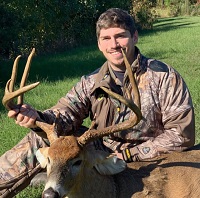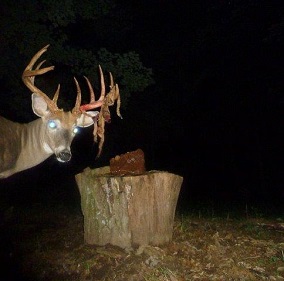Deer season was nearing to a close and I’d only let one arrow fly all season.
One.
And, it was to kill a coyote that came by my stand on an early season hunt. Mission accomplished there, but the deer are what really get my heart pumping.
Since I bow hunt all season long, by that time of year, I usually have tagged a whitetail and filled the freezer. But, that season was been different than most. I’d had quite a few career-related changes that had limited the amount of times I’d been able to get in the woods.

Hunting has provided many “successful” days. But, what really defines “success” in hunting?
So, how did I feel about this?
Well, honestly, I’ve usually begun to get a little bit of an itchy release finger, especially if I haven’t taken a deer yet.
So, during a season like that one, I really began thinking about what defines a successful hunting season.
Maturity In Hunting
It’s a thrill to get to take a mature buck and maybe even take home a set of monster antlers. But, it’s also something that doesn’t come easily, especially when hunting at close range.
I’ve learned over the years that if you want to be in the action when the rut comes, it’s often wise to have been hunting the does all season long. Where do they feed? Where are they bedding? And, where are their travel corridors in between?
Knowing the answers to these questions requires not only logging some time in the stand, but also being patient enough not to start slinging arrows at every deer you see. Bottom line… maturity is required in hunting as well as in life.
Even with the challenges this year that have limited my time in the woods, I have been able to hunt a handful of times. And, I’ve gotten to observe quite a few deer and had the opportunity to shoot many of them. But, I didn’t draw.
-

N1 Outdoors® Tine Lines™ Elk Antler Tee
Price range: $26.99 through $29.99 Select options This product has multiple variants. The options may be chosen on the product page -
Sale!

N1 Outdoors® Compass Tee
$9.00 Select options This product has multiple variants. The options may be chosen on the product page -
Sale!

N1 Outdoors® Est. 2014 Vintage Camo USA Tee
$15.00 Select options This product has multiple variants. The options may be chosen on the product page
As I’ve gotten older, I also see the value in learning all that I can about my craft. Much of that learning comes from hunting with friends and other seasoned hunters.
Everyone has their own strategies and methods for taking whitetail and other wild game. Many hunters might try to prove that their methodology is superior. I simply enjoy the fellowship and sharing of information.

There is a lot to be learned during every hunt. For me, much of it has nothing to do with deer.
I set out to know more every hunting season than I did the year before. This is possible whether I shoot a deer or not. There is always something to observe and learn. And that’s one of the things I love about this way of life.
It’s embarrassing to admit, but sometimes I look to the skyline from my tree stand and realize that it’s been months since I’ve even looked up and around me to observe the beauty and wonder of God’s creation.
Slowing Down The Pace
Life tends to move at a breakneck speed. Technology is not only allowing the flow of information move more quickly, it’s allowing us to get more done in a shorter period of time… which means we pile more and more things on our plates. Which means we move along even faster. I think you see the pattern here.

Sometimes the hunt isn’t about hunting at all.
Life gets crazy and I get wrapped up in finishing the next ‘to-do” on my list. It’s during moments in the stand, that I often realize that I have focused much of my time on trivial things. Whether I’m after whitetail or chasing turkeys, hunting gives me the chance to hopefully get away from all of these distractions for a short time.
Sure, I may have my phone with me to capture the occasional wildlife video, but it sure is nice to not be tied to the computer that I’m currently typing this article on!
I’m thankful for moments in the woods where I can enjoy the incredible attributes of nature that God gave us to show us that there is a magnificent Creator.
Listen Loudly
I hope you are getting a chance to read this in a quiet place. But, chances are, you are cramming this information in as you do other things at the same time. It’s amazing how many distractions technology creates. Getting into that perfect tree stand location not only gives me the opportunity to test my hunting skills, but it also allows me to test my listening skills.
In the quiet of the woods, there are many sounds you can hear that you wouldn’t otherwise. Likewise, maybe there are things that God has been trying to tell me and teach me. What are the things He has been trying to teach me that I have drowned out with the noise of work, family and other duties?
Hunting gives me the chance to evaluate how well I have been listening to the One who gave His life and gives me reason to live. It gives me a chance to listen loudly in the quiet of the landscape. For that, I am truly thankful.
-

N1 Outdoors® RodTogs™ Patch Trucker Hat (Kryptek Typhon & Black)
$26.99 Select options This product has multiple variants. The options may be chosen on the product page -

N1 Outdoors® RodTogs™ Patch Trucker Hat (White)
$26.99 Select options This product has multiple variants. The options may be chosen on the product page -

Multicam Camo N1 Logo Leather Patch Hat
$26.99 Select options This product has multiple variants. The options may be chosen on the product page
Conclusion
So, it’s not just about the kill or the size of the quarry. I don’t have to kill a world record to be happy. Hopefully, I can improve my hunting skills, but also be able to slow down and listen to the what the Lord wants of my life. Now, that is a good definition of hunting success.






























